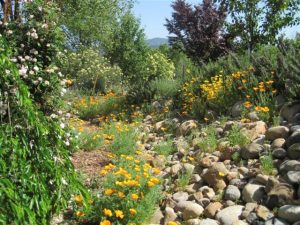I have good news and bad news. The bad news: climate change is creating increasingly hotter, drier seasons. The good news: gardeners can learn lessons from plants that figured out eons ago how to thrive in extreme drought conditions.
Don’t worry. I’m not going to suggest that you replace your landscape plants with saguaro cactus. But understanding how desert plants adapt allows us to look for plants that have similar characteristics. These adaptations are all about gathering, then holding onto, infrequent moisture.
Leaf Structure. Most plants lose the majority of their water through microscopic openings (called stoma) on the leaf surface. To reduce water loss, desert plants employ a variety of strategies.
Smaller narrow leaves. Reducing the surface-area-to-volume ratio of leaves slows evaporation. Our own conifers with their needle-like leaves show dry-climate leaf adaptations.
Light-colored prickly leaves. Many desert and drought-tolerant plants have silver to pale green leaves. Lighter color reflects more light and heat, minimizing moisture loss. Hairy or prickly leaves or body spines gather mist, dew, and rain, which moisten and cool the plant.
Waxy resinous leaves. Some desert plants have a thick, waxy layer that reduces evaporation. Huge yucca and agave leaves are waxy to conserve moisture. Foothill pines employ the same trait with waxy, resinous needles.
Specialized photosynthetic process. In addition to sunlight, plants need to take in carbon dioxide and release oxygen in order to perform photosynthesis, typically through the stoma mentioned earlier. Moisture is lost through those little holes. Some succulents have evolved to close their stoma during the heat of the day so they conserve moisture while taking in sunlight. At night when evaporation rates are lower, stoma open so the plant can “breathe.”
Roots and Succulence. Cacti and other succulents take advantage of occasional rainfall in several ways. Some have tap roots up to 30 feet long to penetrate the water table. Conversely, many cacti have relatively short tap roots but grow extensive, shallow root systems so they can quickly soak up and store surface water from brief, occasional rains.
“Succulence,” from the Latin word sucus meaning “juice” or “sap,” is a characteristic of all succulents, including cacti. Fleshy leaves and organs can contain up to 90 to 95% water.
Drought Tolerance and Avoidance. Plants native to our foothills have another thing in common with desert plants: they often enter dormancy in the extreme heat of summer. They’ll slow or stop flowering and sometimes drop leaves, withstanding desiccation without dying. Some plants avoid drought by having an annual life cycle. They simply die in summer, setting seed for next year’s growth.
In the inevitably hotter, drier future, smart gardeners will research and choose landscape plants that have already figured out how to survive desert-like environments. Selecting garden plants that are either native or suited to your environment has always been a good idea, but as our weather becomes more extreme, savvy plant selection is even more important.
Rachel Oppedahl is a University of California Cooperative Extension Master Gardener of Tuolumne County.

